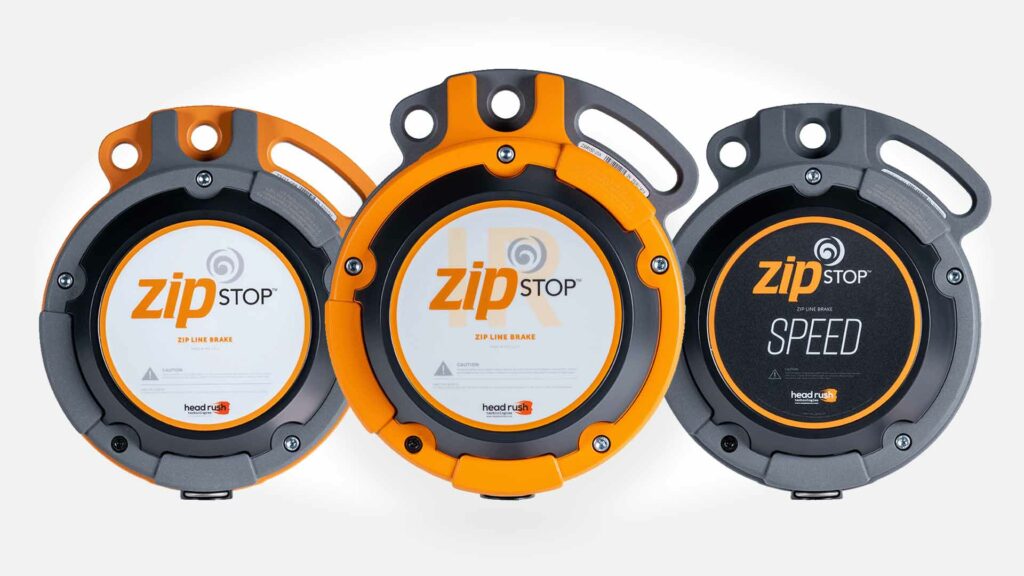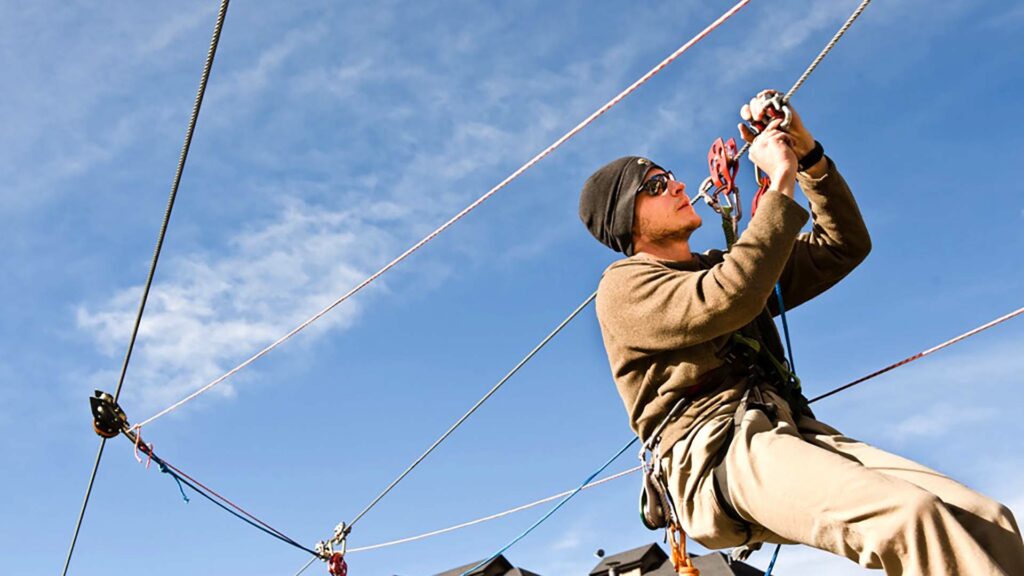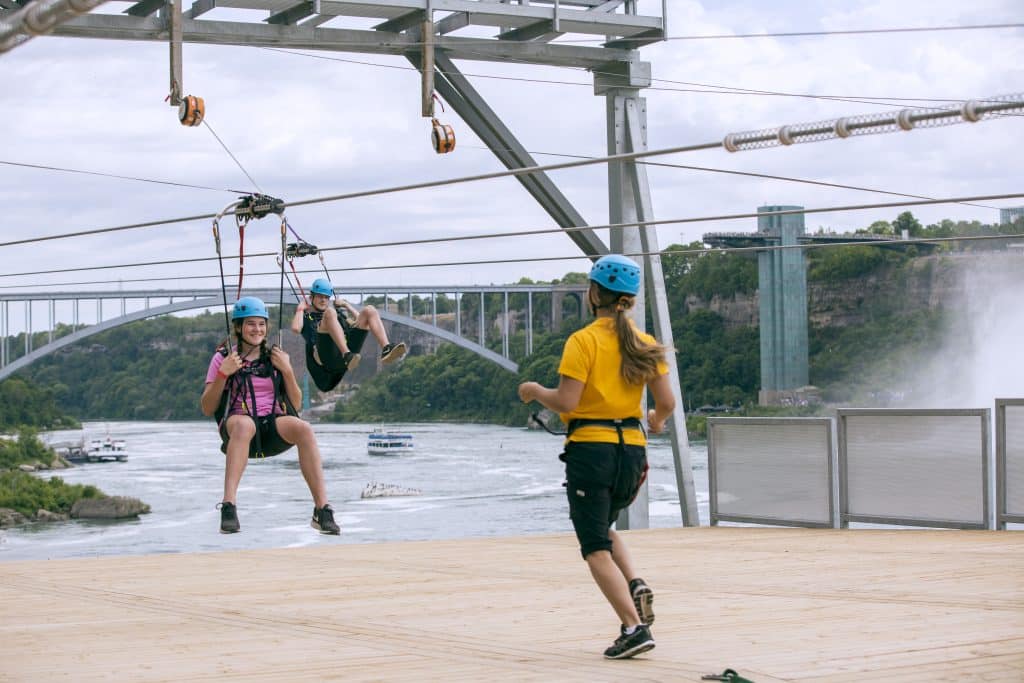Key Takeaways
- Zipline Safety: There is a critical balance between thrill and safety, underscoring the necessity for zipline parks to prioritize rigorous safety standards and regular maintenance.
- Zipline Training and Certification: Comprehensive training and certification for zipline operators is important, and we advocate for continuous learning and emergency preparedness.
- Advanced Safety Technology: Showcasing the advanced safety technology from Head Rush Technologies, we recommend investing in state-of-the-art equipment and fostering a robust safety culture to ensure a secure and exhilarating guest experience.
In a world where thrill-seekers are constantly pursuing their next adrenaline rush, zipline parks have surged in popularity. They offer an exhilarating experience that combines speed, height, and the beauty of nature. As the owner of a zipline park, you shoulder the immense responsibility of providing an unforgettable adventure and ensuring the utmost safety of your guests. Given the inherent risks associated with high-adventure activities, zipline safety is not just a priority—it's an absolute necessity. A well-maintained zipline course with the latest safety technology and rigorous safety standards ensures your guests' well-being and bolsters your business's reputation.
At Head Rush Technologies, we understand that balancing thrill with safety can be challenging. That's why we've dedicated ourselves to empowering park owners with the knowledge and equipment necessary to offer epic adventures that are both thrilling and secure.
This comprehensive guide will delve into essential safety practices, equipment maintenance, and innovative solutions that are key to running a successful and safe zipline park. Drawing upon our experience at Head Rush Technologies, we'll share insights and tips from years of developing cutting-edge safety devices specifically designed for the adventure industry.
Introduction To Zipline Safety
The excitement is palpable as the anticipation builds and your guests await their turn to zip across breathtaking landscapes. However, before the thrill comes the responsibility of ensuring every participant has a safe and unforgettable experience. Through the lens of zipline safety, we aim to empower park owners with the necessary tools and knowledge to lead the adventure industry with confidence, including:
- Understanding Zipline Equipment and Technology
- Quality zipline equipment and the latest technological advancements, like the zipSTOP Zip Line Brake, are critical in ensuring a safe flying experience.
- Training and Certification for Zipline Staff
- The rigorous training and certification programs are important for zipline staff to guarantee precise gear operation, thorough safety checks, and adept emergency handling.
- Cultivating a Safety-First Culture
- Strategies for promoting a workplace culture that emphasizes safety without compromising the exhilaration of ziplining adventures.
- Mitigating Risks and Implementing Safety Protocols
- Explore methods for identifying and minimizing zipline-associated hazards and establishing comprehensive emergency plans and safety procedures.
- Leveraging Customer Education to Enhance Safety
- Highlighting the critical role of educating zipline participants on safety practices to ensure personal responsibility and adherence to safety guidelines.
Understanding Zipline Mechanics And Designs
Ziplines may seem simple, but the engineering behind them is anything but straightforward. Park owners must understand these mechanics to ensure guests' utmost safety and enjoyment.
Zipline designs vary widely, each tailored to the specific landscape and desired experience. Some are short and swift, designed for quick, adrenaline-pumping rides, while others stretch over vast canyons, offering breathtaking views at slower speeds. The length, slope, and tension of the zipline directly affect the speed and safety of the ride, making proper engineering a non-negotiable aspect of zipline construction.
The Role Of Gravity And Tension
Gravity is the driving force behind zipline adventures, pulling riders from the start to the end of the line. However, without the correct tension, a zipline can sag too much, slowing down the rider or making it impossible to reach the end. Correct tensioning, achieved through precise calculations and adjustments, ensures a smooth, safe ride.
Material Matters
The choice of materials in zipline construction is also vital. The cable, typically made from high-grade steel, must be strong enough to support the combined weight of riders and gear with a significant safety margin. In addition to strength, the material's durability against weathering and wear is crucial for maintaining safety standards over time.
Innovative Brake Systems
One of the most critical components of zipline design is the braking system. It is paramount to ensure riders can safely and smoothly come to a stop at the end of their adventure. Innovations in braking technology are designed to provide reliable, adjustable braking that can accommodate riders of different weights and speeds. This technological advancement enhances safety and improves the overall rider experience. This is where the expertise of manufacturers like Head Rush Technologies comes into play.
Key Safety Standards For Zipline Installations
Here's a comprehensive rundown of the key safety standards park owners must prioritize:
1. Comprehensive Engineering Assessments
Before a zipline can welcome adventurers, it must first undergo rigorous engineering assessments. These evaluations focus on structural integrity, ensuring every platform, tether, and pulley is constructed to withstand the expected loads and the unforeseen forces of nature. This includes detailed analyses of wind, weight, and environmental stressors that could affect the zipline over time.
2. Regular Equipment Inspections And Maintenance
The cornerstone of zipline safety lies in the regular inspection and maintenance of the equipment. This includes daily checks by trained staff before operations commence, detailed monthly inspections by certified professionals, and annual reviews conducted by external safety bodies. These inspections focus on wear and tear, structural integrity, and operational functionality, ensuring every component performs as designed.
3. Adherence To International Safety Standards
Safety is a worldwide concern, and adhering to international standards is crucial for maintaining high safety levels. Standards such as ASTM F2959-18 Standard Practice for Aerial Adventure Courses and ACCT (Association for Challenge Course Technology) guidelines provide a framework for design, operation, and maintenance that zipline parks should align with. Embracing these standards demonstrates a commitment to safety and global best practices.
4. Qualified And Trained Personnel
The human element of zipline operations is as critical as the mechanical integrity of the installation. Having a team of well-trained, qualified personnel who understand the nuances of zipline safety is essential. This includes operational training, emergency response, first aid, and customer service. Staff should be proficient in harnessing techniques, emergency evacuation procedures, and regular safety drills to ensure they are prepared for any situation.
5. Emergency Planning And Preparedness
Preparation is the bedrock of adventure. Zipline parks must have comprehensive emergency plans for everything from rescue operations to severe weather conditions. Regular drills, clear communication channels, and accessible emergency equipment are paramount, ensuring a swift and effective response when every second counts.
6. Customer Education And Waivers
An informed adventurer is a safe adventurer. Providing clear instructions, safety briefings, and educational materials about the dos and don’ts of zipline adventures is vital. Additionally, waivers communicating the inherent risks and participant responsibilities are crucial in fostering a culture of safety and awareness.

Training And Certifying Zipline Operators
The key to maintaining the utmost safety on ziplines lies in the rigorous training and certification of zipline operators. These individuals must undergo comprehensive training programs encompass operating procedures, emergency responses, equipment upkeep, and rigorous safety inspections. Operators gain invaluable insights into guest and staff safety through hands-on experiences and a focus on risk anticipation.
Professional development and safety go hand-in-hand, with certification programs provided by recognized bodies serving as a benchmark for operator preparedness while instilling confidence in adventure seekers about the park’s commitment to a secure and enjoyable experience.
Keeping up with the ever-evolving standards of zipline safety calls for a continuous commitment to learning and improvement. This encompasses being current with the latest safety technology, equipment innovations, and training methodologies.
Regular Maintenance And Inspection Protocols
Ensuring the safety and longevity of your zipline attraction requires the initial procurement of high-quality equipment and mandates regular maintenance and inspection protocols.
Daily Inspections
Daily checks should be non-negotiable for zipline attractions. Look for any wear or damage on the cable, pulleys, and harnesses. Check if the braking system is functioning correctly and consistently. Make sure there are no obstructions along the zipline path. Ephemeral issues such as weather damage or wildlife interference can occur overnight.
At Head Rush Technologies, we make it easy to conduct, record, and track regular zipSTOP Zip Line Brake inspections with easy-to-follow checklists and inspection forms.
Detailed Reviews
Beyond the daily checks, a more thorough inspection should be conducted weekly, every 6-months, and annually. This involves examining all hardware and connections for signs of corrosion, fatigue, or loose fittings. It's crucial to assess the structural integrity of platforms and anchors.
Annual Professional Inspections
At least once a year, enlist the services of a professional inspector certified in zipline and adventure park standards. They bring an expert eye to the review process, identifying potential safety risks that might not be obvious to those who work with the equipment daily.
Record Keeping
Maintain a log of all inspections, noting any issues found and the corrective actions taken. This helps track your equipment's health over time and demonstrates a commitment to safety should any legal issues arise. Additionally, these records can inform timely parts replacement before they fail based on observed wear patterns.
Staff Training
Regular refresher courses can keep the knowledge fresh and sharpen the attention to safety details.

Maximizing Safety With Head Rush Tech
At Head Rush Technologies, we understand the critical importance of reliable gear that can weather the unique demands of high-speed zipline experiences. With our commitment to quality and innovation, we have engineered harnesses and ziplining equipment that set industry standards.
Our gear is designed with the adventurer in mind. From our trolleys’ optimized design to our braking systems' precision engineering, every product undergoes rigorous testing to ensure maximum safety.
Ziplinegear technology cannot remain static, so innovation is at the core of Head Rush Technologies. We are pioneers in introducing advanced designs that enhance the safety and durability of our products. Our continuous investment in research and development leads the way in setting new benchmarks for zipline safety gear. Our innovative products include:
- zipSTOP Zip Line Brake: With its innovative self-regulating magnetic braking system, this ensures users experience comfortable and controlled stops, providing consistent braking performance for all weights and speeds, which in turn extends the life of zip line equipment.
- zipBACK Retraction Device: The zipBACK is a simple, reliable, and cost-effective solution for mini zip line rider trolley retrieval.
- LightSpeed EZ Clip Trolley: This dual-line EZ Clip configuration is designed specifically for easy, one-handed installation and provides the most security against a guest or guide dropping a trolley.
Final Thoughts
The thrill of ziplining offers an unparalleled rush. Yet, the essence of delivering an unforgettable experience lies in the unwavering commitment to safety. Head Rush Technologies stands at the forefront, leading the way with innovative solutions that ensure every zipline adventure is exhilarating and exceeds the highest safety standards. Our mission to empower epic adventures for all is embedded in every product we design.
For park owners, investing in top-tier safety equipment isn't just a requirement; it's a statement. It shows your dedication to providing guests with safe, thrilling experiences that will be remembered forever. By choosing Head Rush Technologies, you're not just selecting a supplier but partnering with an adventure industry leader committed to innovation, quality, and the adventurous spirit that defines us all.
Read also:
- Breaking Down the Different zipSTOP Models
- How to Modernize Your Zipline Braking System
- Facility Spotlight: A Day at the Edge Ziplines and Adventures
Frequently Asked Questions On Zipline Safety
What are the safety standards for zipline cable tension?
Zipline cable tension is crucial for safety and the overall experience. The ideal tension depends on the zipline's length and the weight it needs to support. Always adhere to the manufacturer's guidelines and relevant safety standards, such as those set by the Association for Challenge Course Technology (ACCT) or the European Ropes Course Association (ERCA).
How often should zipline equipment be inspected?
Regular inspections are a cornerstone of zipline safety, and daily visual inspections should be conducted to identify any apparent issues. More thorough daily, weekly, 6-month, and annual inspections by qualified personnel are recommended, and an annual professional inspection is recommended to ensure compliance with industry standards and local regulations.
What training is required for zipline operators?
Operators should undergo comprehensive training, including equipment handling, emergency response, and effective communication with participants. Certifications from accredited organizations can further enhance safety and professionalism.
What emergency procedures should be in place for zipline accidents?
Park owners must establish and regularly update a detailed emergency response plan. This plan includes immediate measures for rescue and medical aid, reporting accidents to authorities, and notifying the manufacturer in the case of equipment failure. Regular staff drill sessions are also advised.
How do weather conditions affect zipline operation?
Adverse weather conditions such as high winds, lightning, heavy rain, or icy cables can significantly increase risk. Establish clear guidelines for suspending operations based on weather forecasts and real-time observations. Weather monitoring tools can aid in making informed decisions.
What is the maximum weight limit for participants?
The zipline design, the harness and trolley system capacity, and safety margins determine the maximum weight limit. Manufacturers provide specific limits, but the zipSTOP Zip Line Brake has a maximum working capacity of 330 pounds.
How can park owners ensure harness and helmet safety?
Invest in high-quality, certified harnesses and helmets, and inspect them regularly for wear and tear. Educate participants on the correct usage and ensure all equipment is fitted correctly and secured before allowing anyone to zip.
What are the best instructions for participants?
Before embarking on a zipline adventure, participants should receive clear instructions on posture, braking techniques, and hand signals. A demonstration zipline or thorough briefing can significantly enhance participant compliance and safety.
How should zipline braking systems be maintained?
Whether passive or active, braking systems require regular maintenance to function correctly. Follow the manufacturer's maintenance schedule, which typically includes checking for wear, lubricating parts as necessary, and replacing components that no longer meet performance standards. Review the product manual to find out more about the maintenance requirements of the zipSTOP Zip Line Brake.



